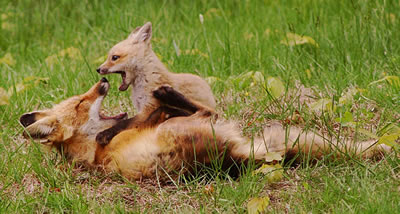Red Fox – Caring for Young

Facts about creatures
- Home
- Animal Classification
- Animal Habitats
- Amphibians
- Arthropods
- Bats
- Birds
- Carnivorans
- Cetaceans
- Chordates
- Crustaceans
- Dinosaurs
- Diprotodonts
- Elephants
- Fish
- Golden Mole
- Insects
- Lagomorphs
- Mammals
- Mammal Teeth
- Marsupial Mole
- Metamorphosis
- Mollusks
- Primates
- Reptiles
- Rodents
- Ruminants
- Soricomorphans
- Tenrec
- Tetrapods
- Vertebrates
Red Fox – Caring for Young
In some red fox families, non-breeding females assist with raising the kits of other females. This increases the likelihood that the kits will survive.
Red foxes mate in January and the vixen (female fox) carries her young for about 53 days.
When spring comes, she begins to dig burrows and clear out unused badger or rabbit holes, looking for a place to give birth.

The burrow that the vixen eventually chooses for her kits (cubs) usually has two or three entrances and may be several yards long, with a number of branching tunnels.
When her kits are born, the vixen stays in the burrow for a few days to over a week.
The dog fox (male fox) brings her food.
The kits live on their mothers’ milk until they are about three weeks old.
Then they begin to gnawing at scraps of meat.
Sometimes, the dog fox will live with more than one vixen.
Some of these vixens, especially the younger ones, do not breed.
The non-breeding vixens will assist with raising the kits.
They will watch them, play with them and bring them food.
Sometimes, they will bring them more food than the mother does.
This helps to increases the survival rate of the kits.
With food supplies (prey) being limited, it may be difficult for the younger vixens to successfully stake out territories and raise kits of their own.
The overall survival rate of kits increases when, instead, they focus their energy on helping to raise the kits that have already been born to another vixen.
Sometimes, the non-breeders will break up the litter so that the kits are in two or three different hiding places. A different vixen will guard each one.
By early summer, the kits are big enough to follow the adults out of the burrow.
As they grow older and more independent, they begin to catch beetles and earthworms.
Some young dog foxes will leave the burrow in early autumn, although others wait until midwinter.
Members of a family may remain in close contact as the summer ends.